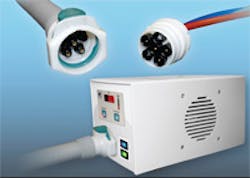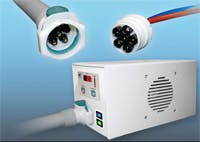With systems continually expanding in capabilities, there is an ongoing challenge to effectively connect all types of clinical, medical, and surgical devices and tools to them. The increasing complexity of these systems — many of which include fluidics, pneumatics, and electronics in a single unit — challenges device designers to incorporate a more complex physical link between the controllers and their end devices. Often, controllers are located up to several yards from where the device is used, so it is critical that connectors provide a streamlined interface between the device and its controller. This requires a new way of looking at connectors — the hybrid connector.
Common applications where these specialized connections are required include laparoscopic procedures, dentistry, cosmetic skin treatments, eye surgery, and liposuction. Any application where there is a need to transfer liquid, air, power, or data to a remotely used tool presents a challenge. Also, any time tools are removed and/or exchanged mid-procedure, a clean, safe, and efficient way to “hot-swap” is necessary.
What device designers are challenged with is reduction of the number and complexity of connections on a device; a tangle of different cords and connectors looks unsophi s t icated and can be confusing for the operator. Any tool or device may have a multiconductor data connector, separate power contacts, several fluid connectors, air for some pneumatic instruments, or temperature and/or pressure regulating connections, so it is easy to see how complicated the interface can become. Innovative engineers have discovered that integrating all connection points into a single, easy-to-use hybrid connector is the ideal solution.
One single connection
Hybrid quick connectors allow the device to have one single connection point to make all fluid, electronic, and other connections between a tool and its controller. Initially, hybrid connectors were attempted in-house by device designers wanting to integrate simple fluid and electronic connections. Because liquids and electronics don’t mix, this integration wasn’t even feasible until dry-break fluid connector technology was fully developed. Dry-break technology eliminates fluid drips upon disconnection, enabling fluid connectors and electronics to co-exist in close proximity.
Until recently, device designers consolidated multiple connections into single “umbilical” lines that connect their tools to the control units themselves. To save time and money, device designers turned to connector manufacturers to solve these challenges, making a single device incorporating electronics and fluidics a reality. These connectors reduce device size and complexity for the end user, and increase the overall safety of their equipment.
Vacuum or compressed air lines are needed when pneumatic instrumentation is involved. All additional lines, regardless of what they are, feed into and through the connector which also contains the integrated electronic lines — one plug, multiple sources.
The single connection point of an umbilical interconnect makes connecting equipment cleaner in appearance and user friendly. Where multiple hand pieces are used for a particular procedure, a hybrid quick disconnect at the end of their instrument allows for a quick change to a different hand piece or device.
Added safety
Making the hybrid connector “smart” is the next step. All types of equipment used in a range of aesthetic, medical, and surgical arenas benefit from tracking of the connection/use process. Although definitely not the only area where this is a benefit, one that stands out is disposable instruments. Such components are monitored closely, but re-use does occur, and it can put the manufacturer in a dangerous position from a liability standpoint. Building safeguards into the initial device designs can reduce the likelihood that their disposable components can be improperly re-used.
A smart hybrid connector is one method for this type of safeguard. These connectors incorporate an embedded RFID tag which can be pre-programmed with data relating to batch number, date code, or whatever data that manufacturer deems necessary. Upon initial connection of the surgical instrument to the control device, the device will read the data that is stored on the tag located in the disposable portion of the connector to determine if the disposable component is approved for use.
Once the procedure or treatment is complete, the device writes a code to the tag noting that the disposable tool has been used. This information is now stored on the tag and if the disposable component is connected a second time the control device can refuse to allow its use. The operator must then replace the tool with an unused one in order to complete the procedure.
This technology can be used in procedures that require sequential tools to be used. The embedded RFID tag can be pre-programmed so that the tools cannot be connected in the wrong order. If there is an attempt to connect up tool B prior to tool A, a warning can be displayed on the controller.
The information stored on the RFID tag can be used in a variety of ways. The device controller can configure itself based on the hand piece tool or component connected, eliminating the need to set up or program the device. The device can record what components were used and when, or ensure that expired products are not used. Consider a procedure that uses two different pneumatic hand tools. Each of these tools requires a different input pressure to operate properly. The embedded tag can contain the data regarding what pressure should be output to the tool. When the hand tools are swapped out, the controller automatically detects, via RFID, what the output pressure should be and adjusts it without the need for manual adjustment or mechanical contacts. The applications for this technology are vast and broad.
Growth in industrial settings
This technology is easily adapted to industrial settings as well. Hybrid connectors can be used to improve and streamline the assembly process for modular systems that require multiple electronic and pneumatic connections. Modular systems can be quickly set up and operational, by using hybrid couplers as the electro-pneumatic interface between components.
Hybrid connectors can also be used to combine multiple tubes and electrical connectors on equipment panels, reducing assembly time as well as preventing misconnections. Finally, they can connect robotic arms that require both electrical and pneumatic power. Quick connect hybrid connectors make changing and servicing robotic arms and tools more operator friendly and can reduce maintenance downtime.
For more information, visit www.colder.com, or contact Jaime R. Erickson, engineering solutions manager, at (651) 603-2541 or [email protected].
About the Author

Leaders relevant to this article:

